 |
| by Mark
Steele - Auckland, New Zealand
A model yacht
crossing of Cook Strait,
Mick Brown’s wife
Marion’s schooner,
and a model of
the ill-fated Strathcona.
|
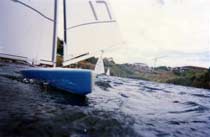
Photography from on board a
model multi-hull, and a model
with style and much detail. |
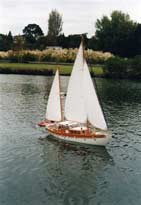
|
Alan Hayes, now living in Kerikeri in
the Bay of Islands, New Zealand, at one stage when
ultra-keen on model 1m yachts successfully rigged
up a camera aboard a trimaran model of his in order
to take photos of other models from the lowest possible
position to the level of the water. Here (above left)
is one of his shots of a 1m literally flying downwind,
a photograph that I think is quite impressive. The
second photograph is of one of Aucklander Roy Lake’s
many models built over a lengthy period of years.
The 1/15th full size model (Flamingo) is
an accurately scaled version of a 72’ steel
ketch still sailing in the waters of Auckland’s
Waitemata harbour called The Dove. Roy built
the model around a solid timber core of building pine,
the model taking 1,700 hours of work over a period
of eleven months. It is incredibly detailed within
the cabin and an impressive sight on the water.
`I sail my boat just
for the hell of it (said the windler at the pond)
the tide is flowing so where are we going, across,
behind or beyond?
then again t’is I who will say WHEN we will
go wherever we are going,
and the mystery is, (cos I’m in a tizz) not
even ME is knowing!’
My friend, the late John Spencer, the famous yacht
designer used to say that there was nothing wrong
with sailing model sailboats in salt water, indeed
the launching of both of my Spencer yachts took place
in ocean water in the Bay of Islands. “So long
as you keep the water outside the boat and hose the
model down lightly after sailing, you’ll have
no corrosion problems”. This leads my memory
to recall a wonderful adventure sail, a model yacht
crossing of Cook Strait, that oft-infamous 25 mile
stretch of ocean water separating New Zealand’s
North and South Islands.
“It seemed a fun thing to do”, the late
Euan Sarginson of Christchurch, New Zealand told me
after it was all over, and I will always remember
his cellphone call to me that night from onboard a
friend’s yacht somewhere in Cook Strait, in
which he told me that his 1950’s A Class model
yacht, William Fraser was three quarters
across heading for Wellington. It was more than that
for Euan was so passionate about the older veteran
model yachts and like me believed that model yachts
had many roles other than racing. He loved the older
boats, procured many of the four foot six class boats,
restored them, treasured them and sailed them. He
was a great model yacht icon who died after a short
illness in 2004.
With a support crew from the Christchurch Model Yacht
Club, the oldest in the country and aboard a friends
yacht, cross the strait they did, the model surviving
big Pacific rollers and a following, investigating
shark and only having to change batteries by hanging
over the side of the yacht in order to do so. It was
a wonderful achievement and the weather though kind
with the seas in good mood, the feat illustrated how
versatile a model yacht, well built, well cared for,
and well prepared could be.
If someone called you a `gongoozler’
should you be insulted? It is a person who stands
around on the waterfront with his hands in his pockets,
watching other people do things and the word is British
Waterways slang.
Mick Brown of Essex in England is a boatbuilder for
an International company building yachts where he
has been employed for the last 20 or so years. A keen
modelbuilder in his spare time his first yacht was
a Kyosho Fairwind but don’t go thinking
that he merely just slaps everything together. Take
a look at the photos above of the four and a half
foot long Robbe `Atlantis’ schooner,
Amarantha he has just put 362 hours into
building for his wife Marion also a keen model sailor.
They sail together at a nice boating lake at Maldon
in Essex which has recently been refurbished. Mick
is now laying the decks of the Robbe model schooner
Valdivia for himself to be called Blue
Amazon.
|
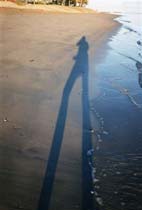
|
Phooey claims disputed! No truth whatsoever in the
belief of some folk, that you can either catch fish
and sail an RC model yacht at the same time using
a transmitter as Aucklander, Alexander Bartlett might
lead you to believe, or that the more you sail a model
yacht in the warm waters of the Fiji Islands, the
longer your legs grow as a certain writer might claim.
So long as you enjoy a bit of fun and don’t
take sailing of the windling kind too seriously!
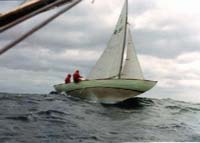
To beat the storm
|
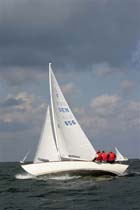
|
A photograph I have always loved is this one taken
by Finn Hartvig from his folkboat D544, of Erik Andreasen
at the tiller of D541 Tibbe, the latters
own folkboat in force 9-10 winds on the Baltic Sea.
Both boats were under full sail and carrying families
with small children so one certainly senses an impending
storm and the urgency to reach safe harbour. Eric
is a very famous sailor in Denmark who has won the
Gold Cup for folkboats on more than one occasion.
This photograph which I have used once before in Windling
World is again reproduced kind courtesy of him and
Finn Hartvig.
In March 1977 Erik founded Folkebad Centralen A/S
to build and market the Nordic Folkboat, a mould having
been taken of D51 Tibbe in order to secure
the future of this type of boat. To date over 1,000
folkboats (picture above, right) have left the modern
boatyard built for the purpose in Kerterminde in Denmark.
I’ve seen model power boaters deliberately
heading for ducks which is not a good idea for they
have just as much right to use the ponds or lakes.
I have only once seen a model yacht sailor `duck hunting’,
not so my mate John Stubbs whom I remember took extreme
care to veer off and `come about ‘ rather than
go between these duckling in the first of two photos
above. After all, our Auckland, New Zealand Ancient
Mariners group even have an annual Footy race for
the Quackers Trophy.
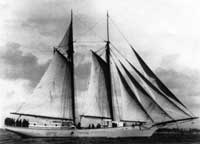
Strathcona
|
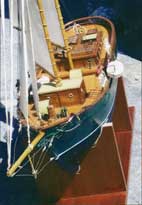
|
I have written about my good friend, Ken Impey in
Falmouth, Cornwall before, but not of his schooner
model, Grace Mary (above) which was modeled
after the ill-fated schooner Strathcona.
According to New Zealand historian and yachting writer,
Paul Titchener, the 110’ Charles Bailey designed
schooner having set to sea with 13 crew aboard on
Friday June 13th in 1915 then hit the North Minerva
reef in the Pacific on her maiden voyage. The schooner
had defied superstition and her departure on that
date was considered a bad omen. She was on a reach
when it happened and while logging eleven knots at
high tide when she ploughed through the razor sharp
coral landing out of the ocean with her sails still
drawing. Taken by her beautiful lines and moved by
the story Ken built the model and named her Grace
Mary after his daughter. The RC model faithfully
captures the beautiful lines of the Strathcona
and is a favourite of the builder.
|
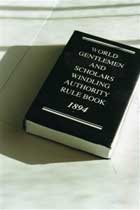
|
It is a sizeable and heavy(ish) book full of pretty
well nothing much more than an impressive and authoritative
looking cover, The World Gentlemen and Scholars
Windling Authority Rule Book 1894. However it
does clearly list the need for sailors to be true
`gentlemen’ (the word `ladies’ was added
in 1907 at a special extraordinary meeting held at
a Round Pond in London) and stresses the etiquette
of sailing conduct required. The ‘scholars’
reference on the cover was added at the specific request
of Lord Perivale `Bugsy’ Bagot who was Chairman
at that meeting, though most of those that attended
were unable to agree when conducting head counts in
order to determine how many actually attended, since
several owners had brought their dogs and it was feared
that they were counted! (That speaks volumes for `scholars!’)
Included however are some interesting but unusual
stories such as the one about the Carruthers Brothers
whom history suggests, built a whole fleet of three
foot long model sailing boats near where they lived
in a town of less than three hundred in the 1800’s
at what was then known as Whangaoparaonga which was
a remote settlements on an eastern coast of a land
in the Pacific. The father (whose own father had come
out from Scotland) had died, and six sons, their mother
and two husbands of their one deceased sister were
made working partners, hence the reference in the
company title to `others’. Their store sold
all matter of goods but built up a thriving business
building and exporting to the major cities of the
country their fast inexpensive free-sail boats, none
of which remain. The book is very rare today, (just
one copy exists!), so my being aware of who owns it,
even Amazon will be unable to procure one. However
if a thousand people were all to ask at their local
booksellers, this might well result in someone (probably
me!) writing the book! On that note I will just say,
don’t always believe absolutely everything I
write, and I look forward to seeing you next month
`where the winds blow’.

Click
here for previous Columns by Mark Steele

|